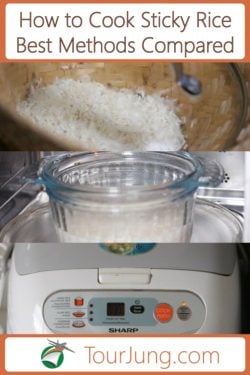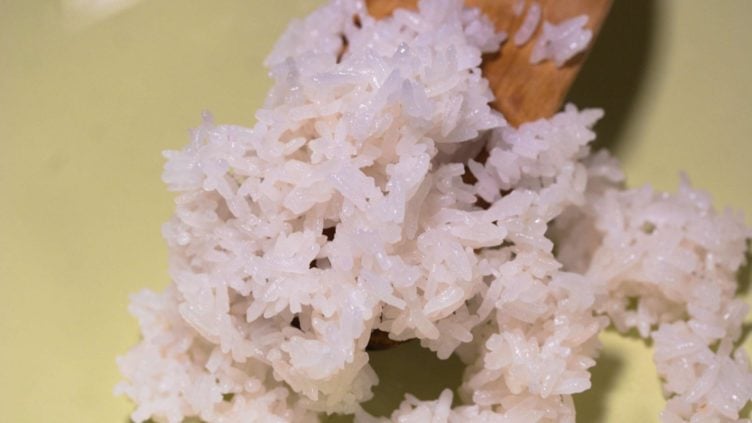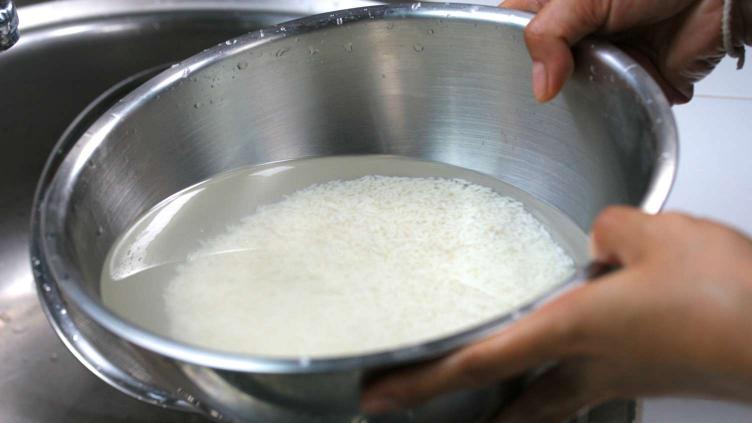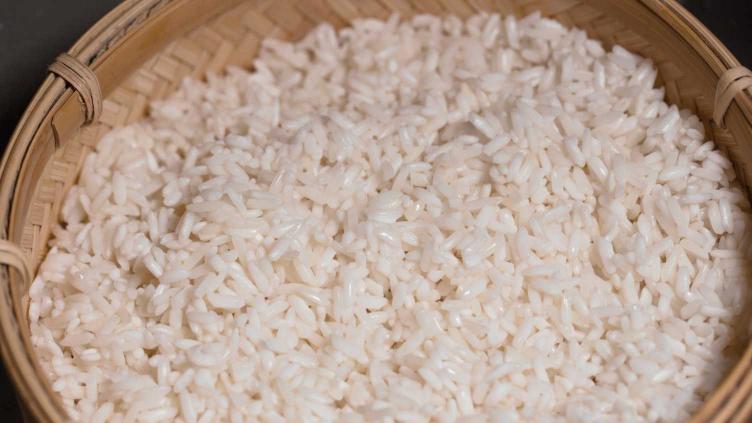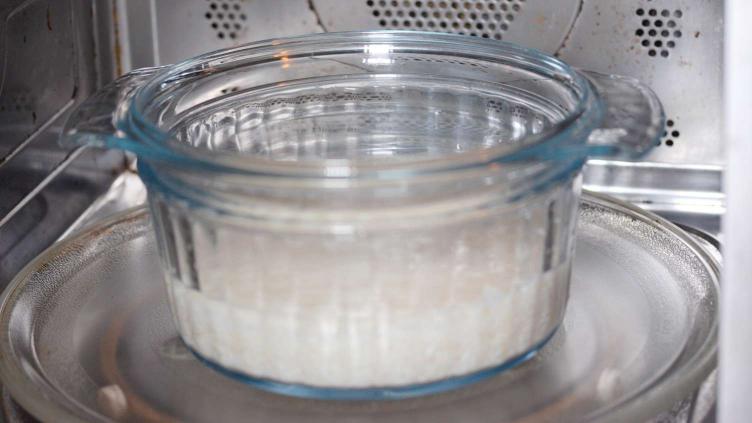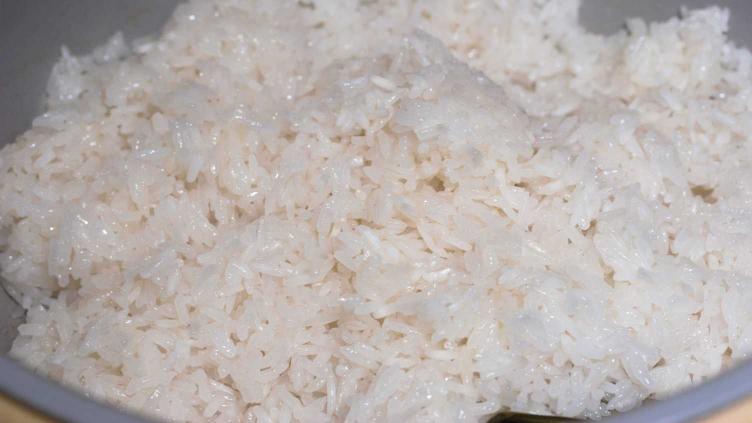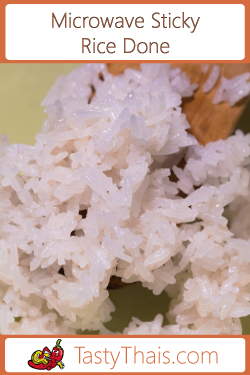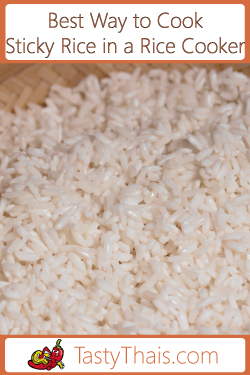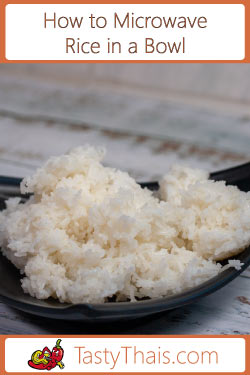Sticky rice is also known as “sweet rice” as well as “glutinous rice” depending on the packaging, but it all refers to rice that feels sticky to the touch and sticks together nicely when picked up with the fingers.
Thai people still eat some things with their fingers and sticky rice is a great way to savor the different sauces and dips that are so often served as part of a Thai meal.
Links disclosure: Some links on this page go to affiliate partners where, without cost to you, we may receive a commission if you make a purchase.
Links to the Best Methods
Traditional and Grandma’s Method on the stove with a bamboo steamer.
Microwave Sticky Rice Method
Rice Cooker with Basket Insert
Cooking with an electric steamer or over a saucepan (new method that works brilliantly too)
Sticky Rice is also a popular restaurant menu item because it stands apart from regular rice and is just something special. There’s a motherlode of different dishes it is used for in Thai cooking, which makes it pretty versatile.
Cooking sticky rice can be a little challenging and so we wanted to explore six different ways you can cook sticky rice and show you the benefits and issues with each method.
What You Must Do Before Cooking Sticky Rice with Any Method
Sticky rice is glutinous rice which means it has a lot of starch. It is the starch in the rice which makes it sticky.
In contrast to risotto, for example, sticky rice is intended to be picked up with the fingers and to be quite ‘stickily dry’ to the touch. When cooked it will retain the ability to absorb liquids which makes it great to suck up sweet or savory sauces which makes it uniquely tasty.
So before cooking you absolutely must wash the rice thoroughly to remove the excess starch on the outside of the grains. If you skip this step you will end up with a homogenous mass of stickiness which is not what we are after.
So place your rice in a large bowl and pour over double the amount of water. Swill around with your fingers so the rice tickles you lovingly as you wash off that starch. The water will turn a milky color as you wash the rice.
Just pour the milky water away and refill, repeating the process four or five times to get the rice de-starched. The water may still be a tiny bit unclear which is fine.
Next, you will cook the rice according to your chosen method. All of the methods below produce edible sticky rice but vary in quality of taste so do read on.
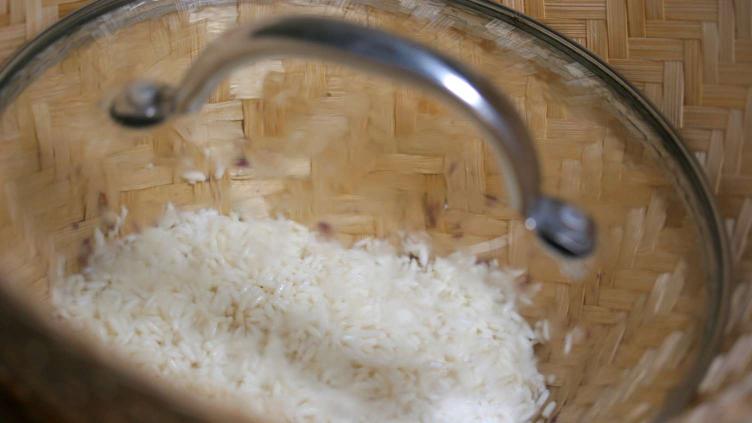
Method 1 Long Pre Soaking the Sticky Rice and Cooking in a Bamboo Steamer
Read the full method and print the recipe.
This method is “Grandma’s Method” and is the most common way that sticky rice is cooked by ordinary Thai people.
It produces sticky rice that is excellent and tastes exactly as it should with the right blend of stickiness to moistness – neither too wet nor too dry. That is probably why Thais still swear by this method.
The exact details of this method are on the recipe page so we won’t repeat them in detail. But once the rice has been washed, you soak it for several hours and then steam the rice over a pot of boiling water in a bamboo steamer.
The sticky rice that this method produces will give you results that will match the best Thai restaurants. Sticky but not wet, a slightly beige color, each grain cooked but with bite left and plenty of absorbability.
Method Rice Quality Rating: 10/10.
Conclusion: If you have time and you have the equipment then this method produces the best results.
Method 2 Long Pre Soaking the Sticky Rice and Cooking in the Rice Cooker in a Steamer Basket
Click for the full explanation and easy print recipe.
In this method, the rice is also soaked for several hours to soften and is then placed in a small steaming basket in a rice cooker.
Many rice cookers have a glutinous rice setting, but in this method, you set the rice cooker for normal rice and add water below the rice to steam it.
It is slightly less hassle than cooking with a bamboo steamer in that you can leave it to cook while you go to do something else. The rice cooker will turn itself to warm when it’s done and there will be no pan to boil dry – a problem you would face with Method 1 if you left it unattended.
We purchased the small bamboo basket specifically made for the task for this test and have to confess were very skeptical it would produce anything edible, never mind good sticky rice.
The outcome was sticky rice that was very nearly as good as the traditional method above. Neither too wet, nor too dry. Just the right stickiness and a lovely light beige color.
Method Rice Quality Rating: 9/10
Conclusion: An very acceptable alternative method to the traditional method that is great if you have a rice cooker and need to leave the rice to cook unattended.
Method 3 Short Pre Soaking the Sticky Rice and Cooking in the Microwave
The complete method and easy recipe is available here.
If you are short of time, the long pre-soaking required by the traditional and rice cooker basket methods above can be an issue.
Imagine guests are arriving and you have forgotten to cook the sticky rice – or decide you need it at the last minute. Soaking for hours is not going to be an option.
What to do?
Assuming you have a microwave then you can short soak the rice and then quick cook it in the microwave.
Once again we were skeptical that this method would produce sticky rice of a decent quality.
We were wrong!
The sticky rice it produced was slightly softer, slightly more moist and stickier than methods 1 & 2 above, but only slightly. Just about as good as those methods although the rice was whiter in color but tasted just about as good.
Microwaved rice, surprisingly, produces perfectly acceptable sticky rice and if we were not comparing different methods then we would not have guessed this was microwave rice.
Method Rice Quality Rating: 9/10
Conclusion: If you are short of time and have a microwave then this method is the quickest and almost on par with the best.
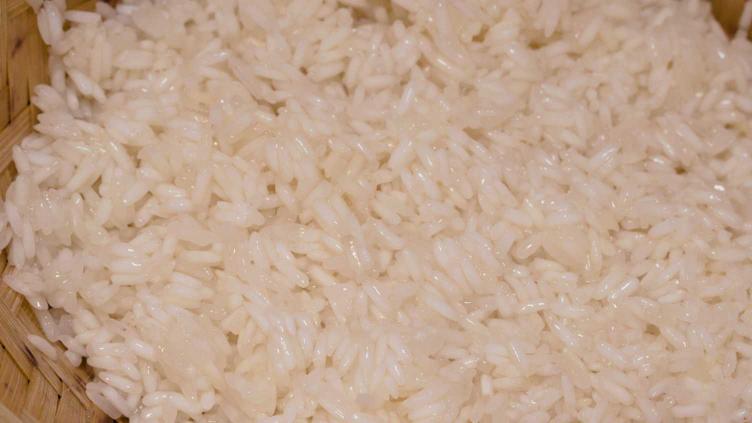
Method 4 No Pre Soaking the Sticky Rice and Double Cook Method
In Laos, a popular method of cooking sticky rice skips the soaking time and proceeds straight to cooking in the bamboo steamer as in “Grandma’s Method” above.
The rice is part-cooked and then rinsed and cooked a second time – all done in the bamboo steamer over a pot of boiling water.
We found the method itself to be more labor-intensive than most of the other methods and although it works we were not really impressed.
For all the effort, the sticky rice turned out a bit too sticky and wet and simply did not taste quite so nice as the other methods above. It was quicker and the sticky rice would do at a push but it is not going to be our preferred method of cooking sticky rice.
It could be that your mileage could differ if you try experimenting with timings but we concluded it was not worth the effort. It is not that the sticky rice was bad but it certainly was not great.
Method Rice Quality Rating: 7/10
Conclusion: If you are in a hurry, the microwave is broken and the bamboo steamer you found in the cupboard has unraveled itself then use this method at a push.
Method 5 No Pre Soaking the Sticky Rice and Cooking in a Rice Cooker
If you have a good quality, upmarket rice cooker then chances are that it has a setting for cooking glutinous rice. In the model we used which is a Sharp, the instructions call for no pre-soaking which leaves you expectantly happy at the time-saving.
Plus you can throw the rice in, add water, press the on button and clear off to do something useful. You may dream of coming home to wonderful sticky rice.
Unfortunately, the results are not dream-fulfilling. The rice is sticky but rather sticks together too easily and even fork fluffing is unable to resuscitate it to a quality acceptable for immediate consumption.
All is not lost though if you want to use it with further preparation, on the BBQ for example as Khao Nieow Ping brushed with melted butter or some other recipe.
Method Rice Quality Rating: 5/10
Conclusion: A quick and hands-off method that is OK if you are going to do something other than serve the rice as it comes.
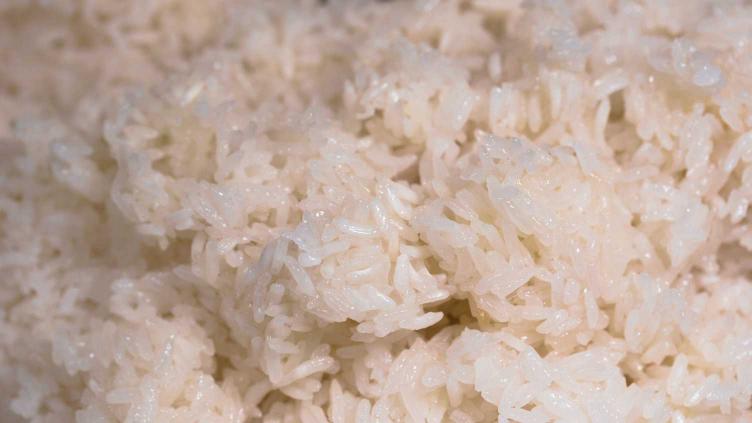
Method 6 No Pre Soaking but Boil the Sticky Rice and then Cook
Another method that seeks to avoid the time spent soaking the glutinous rice before cooking.
This method involves part-cooking the sticky rice in boiling water and then finishing off in the bamboo steamer.
Why you might reasonably ask?
It suits if time is short but the results are even worse than the rice cooker regular method since the rice comes out wet and mushy and doesn’t taste right.
Now maybe we boiled too long, steamed too long or missed some crucial step and you are welcome to experiment. But for a quick method experimenting is not much help so you’d best get practicing if you intend to cook sticky rice this way.
Method Rice Quality Rating: 4/10
Conclusion: It saves a bit of time if you are disorganized or in a rush for whatever reason but the recipe we used was simply not good enough.
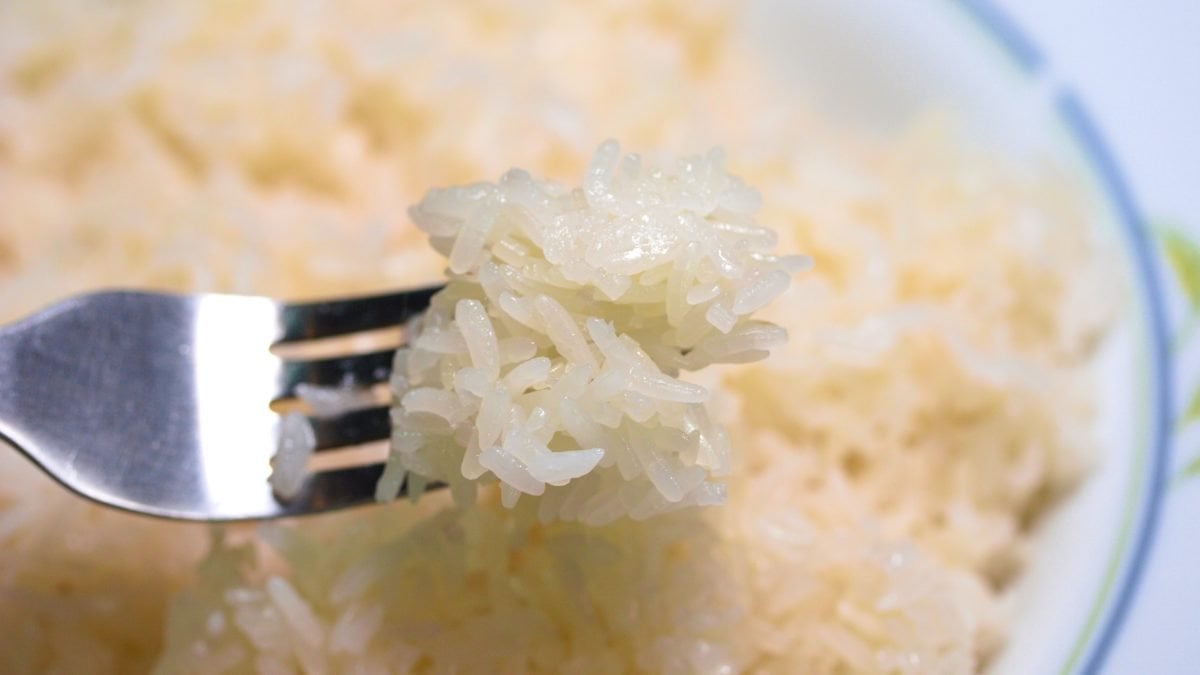
Overall Conclusion
If you want the best sticky rice result then follow “Grandma’s Recipe Method” which is the traditional method and still the best.
We are not against traditional things, happy never to have fought with the mangle and scrubbing board thanks to the washing machine for example, but sometimes traditional is best.
If you have a microwave and want a quick method then our microwave rice recipe is really great and almost as good as a backup or if you haven’t got a bamboo steamer yet.
Failing that try the bamboo basket in rice cooker method which has the benefits of using a rice cooker – you can leave it alone and be productive elsewhere for example – and the results are great.
If you have no time, no rice cooker and no microwave but have a bamboo steamer then go for the double cook method.
If all else fails or you are not super fussed about perfect sticky rice as it will be repurposed then, by all means, use the other cooking method recipes. As it stands the rice cooker standard method barely outperforms the boil and steam method but as discussed adjusting timings might render the boil and steam method viable. We will experiment further one day.
Happy steaming!
Related Posts in This Method Series

I am a Thai mum and love cooking for my children. Over the years, I have taken my family recipes as well as ones borrowed from friends and adapted them to make them even tastier. I publish my authentic Thai Food Recipes here for all to enjoy around the world. When I get a chance to travel I publish information to help others visiting Thailand.
